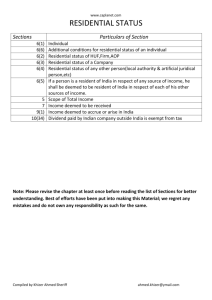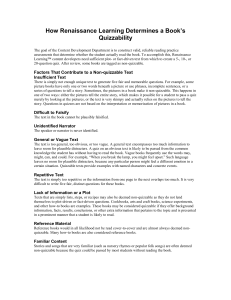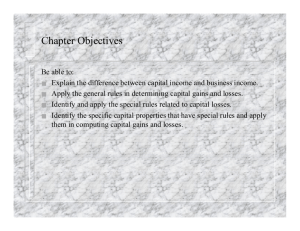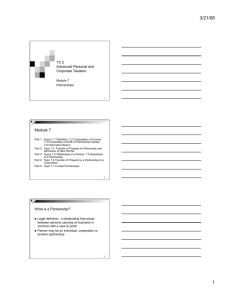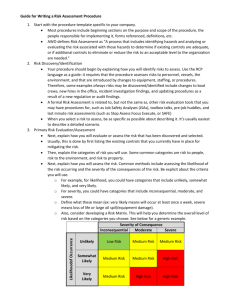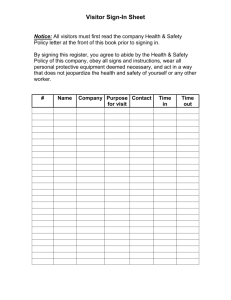Partnerships
advertisement
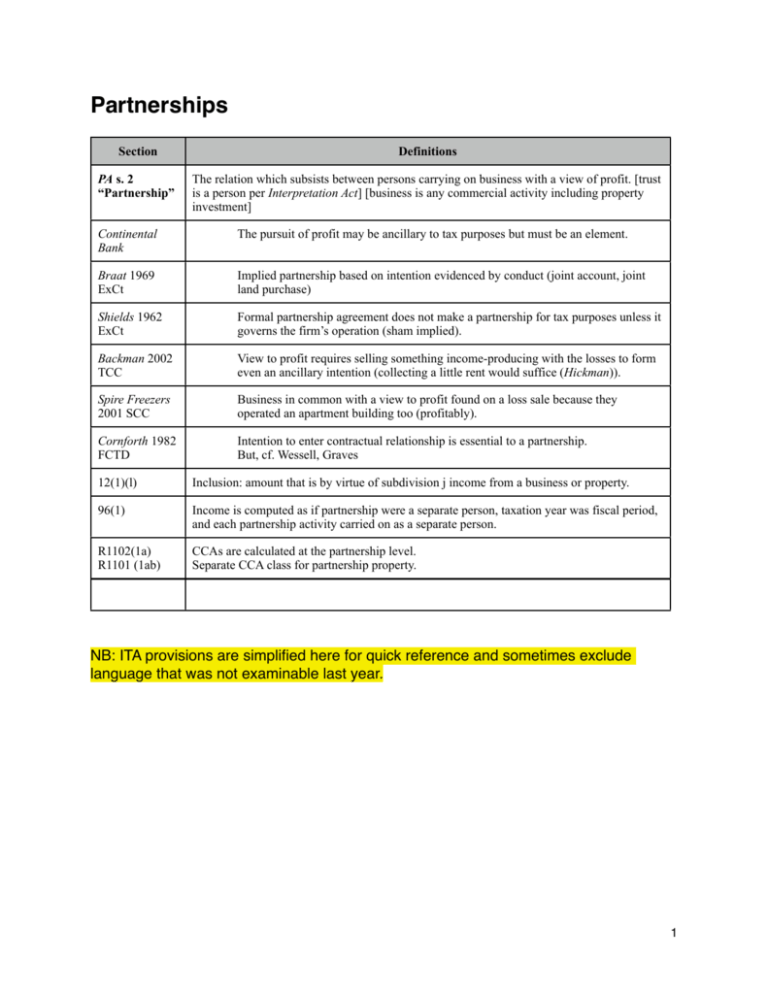
Partnerships Section Definitions PA s. 2 “Partnership” The relation which subsists between persons carrying on business with a view of profit. [trust is a person per Interpretation Act] [business is any commercial activity including property investment] Continental Bank The pursuit of profit may be ancillary to tax purposes but must be an element. Braat 1969 ExCt Implied partnership based on intention evidenced by conduct (joint account, joint land purchase) Shields 1962 ExCt Formal partnership agreement does not make a partnership for tax purposes unless it governs the firm’s operation (sham implied). Backman 2002 TCC View to profit requires selling something income-producing with the losses to form even an ancillary intention (collecting a little rent would suffice (Hickman)). Spire Freezers 2001 SCC Business in common with a view to profit found on a loss sale because they operated an apartment building too (profitably). Cornforth 1982 FCTD Intention to enter contractual relationship is essential to a partnership. But, cf. Wessell, Graves 12(1)(l) Inclusion: amount that is by virtue of subdivision j income from a business or property. 96(1) Income is computed as if partnership were a separate person, taxation year was fiscal period, and each partnership activity carried on as a separate person. R1102(1a) R1101 (1ab) CCAs are calculated at the partnership level. Separate CCA class for partnership property. NB: ITA provisions are simplified here for quick reference and sometimes exclude language that was not examinable last year. 1 Section 2 Anti-avoidance rules 69(1)(a) (Except as provided elsewhere, i.e. rollovers, stop loss) Where a T has acquired something from non-arm’s-length person at more than FMV, deemed acquired at FMV. 69(1)(b) (Except as provided elsewhere, i.e. rollovers, stop loss) Where a T has disposed something to non-arm’s-length person at less than FMV or by gift, deemed proceeds at FMV. 251(1)(a) 251(2) Related persons are deemed non-arm’s-length, otherwise a question of fact. Related persons are connected by blood, marriage/CL, adoption (corps based on control). Madsen Deptuck both 2001 FCA Partnerships as “related persons”: deeming rule applies to the fictional separate person under 96(1) (a partnership is both “person” and “taxpayer”) and the controlling mind of the partnership is the “related person.” 103(1) Income/loss allocation where: 1. partners agree to share partnership income/loss (or certain other amounts); and 2. the principle reason is reasonably considered tax reduction/postponement. Result: deem their shares to be an amount that is reasonable in the circumstances. (applied Xco, but not for loss trading in Stowe) 103(1.1) Income/loss allocation where: 1. non-arm’s length partners agree to share partnership income/loss (or other relevant amounts); and 2. any member’s share is not reasonable in the circumstances. Result: deem their share to be the reasonable amount. (applied Archbold) Section Partnership Interest: Nature and ACB Strauss 1960 ExCt A partnership interest is capital property distinct from underlying property (unless you’re buying and selling PIs as a business so as to make them inventory). 43(1) ACB of part of property on disposition is the portion of ACB reasonably attributable to that part. 53(2)(d) In computing ACB of retained portion of property, deduct the s. 43 amount for the disposed part. 54 The ACB of non-depreciable capital property is the cost as adjusted in accordance with s. 53: 53(1)(e)(i) add “all amounts each of which is the taxpayer’s share... of the income from any source” 53(1)(e)(iv) add amount of capital contribution (except to the extent reasonably regarded as a benefit conferred on a related member). CRA includes an assumption of a partnership liability. 53(2)(c)(i) reduced by the taxpayer’s share... of any loss of the partnership from any source 53(2)(c)(v) reduced by any distributions of the taxpayer’s share of profits or capital. 40(3) Deems “negative” ACB a gain, but not for partnerships as (a) excludes the reductions in 53(2)(c) 100(2) “Negative” ACB deemed a gain on disposition of a partnership interest. [also on retirement/windup by different sections] Stursberg (cf. Strauss) Characterize disposition vs. distribution: a distribution changes the residue of the capital account, so if you get something back while reducing your interest it’s a disposition. 3 Section 96(2.1) Where T is a “limited partner”, T’s “limited partnership loss” (the excess of T’s share of the partnership’s loss over T’s “at-risk amount”) cannot be deducted in that year (applied in Brown 2003 FCA--note “3-year period” application). 111(1)(e) The “limited partnership loss” may be deducted in a subsequent year to the extent of T’s “at-risk amount” in that year. 96(2.2) Defines T’s “at-risk amount” as the total (>0) of: a) the ACB to T of his partnership interest; plus b) T’s share of the partnership income at the end of the fiscal period (computed per 53(1)(e)(i)); minus c) amounts owing by T to the partnership; and minus d) any amount/benefit T might receive to reduce impact of any loss. 96(2.4) Defines a “limited partner”: 1. member of a partnership at a particular time; 2. if, at that time or within 3 years after: (a) their liability is limited under partnership law; (b) they or someone non-arm’s-length is or will be entitled to an amount/benefit to reduce the impact of a loss; (c) a reason for the member’s existence is reasonably considered to be limiting liability of any person and can’t reasonably be considered to carry on business in the most effective manner; or (d) an agreement for disposition of a PI is reasonably considered to be an attempt to avoid this subsection. 40(3.1) 4 Limited Partnerships: At Risk Rules and Deemed Gains Deemed gain on “negative” ACB at end of fiscal period for: 1) “limited partner” or 2) “specified member” at all times since becoming a member. 53(1)(e)(vi) Will then add the deemed gain to the ACB. The gain will increase ACB to 0. 40(3.14) Defines “limited partner” for 3.1 as in 96(2.4). 248(1) Defines “specified member”: limited partner in the year; or a member who is not active in partnership business other than financing or carrying on a similar business other than as a member. 40(3.2) 40(3.1) doesn’t apply when already another kind of deemed gain. 40(3.11) Calculates the deemed gain as the negative ACB: total of 53(2) amounts minus the partner’s cost and 53(1) amounts. 40(3.12) Elect loss for positive ACB to extent of previous deemed gains. 40(3.13) SAAR for something else dressed up as a capital contribution 40(3.131) SAAR where avoidance of 40(3.13) is reason for not having been specified member Section Transferring Property to a Partnership 97(1) general rule Deemed FMV disposition and acquisition where partnership acquires property from a member. 97(2) Elective rollover if: 1. taxpayer disposes qualifying property (includes capital property and inventory); 2. to a Canadian partnership (all members resident per 100(1)); 3. of which T is a member (immediately after that time) 4. (and all partners elect in prescribed form within time referred in 96(4)) Then, apply the rollover rules as follows... 85(1)(a) modified by 97(2)(a) The elected amount is deemed to be the proceeds of disposition and the partnership’s cost, subject to... 85(1)(c) modified by 97(2)(a) ...the upper limit is FMV and... 85(1)(b) modified by 97(2)(a) ...the lower limit is the boot (subject to FMV upper limit) but not less both FMV and UCC/cost of depreciable property... 85(1)(c.1) modified by 97(2)(a) ...for inventory and non-depreciable capital property, agreed amount is increased to lesser of FMV and T’s cost... 85(1)(e) modified by 97(2)(a) ...for depreciable property, agreed amount is increased to least of: 85(1)(e.2) modified by 97(2)(a) 85(1)(f) modified by 97(2)(a) 1. UCC to T of all property in that class; 2. T’s cost; or 3. FMV... ...if the consideration is more than both the FMV and agreed amount and the extra is reasonably regarded as a benefit desired to go to a related person, then the excess is added to the agreed amount. Cost of the boot: is deemed the lesser of its FMV and the proportion of the FMV of all disposed property that the boot is of the FMV of all boot. 97(2)(b) Adjustments to cost: the agreed amount, less FMV of boot, is added to the ACB of their partnership interest. If boot exceeds FMV then deduct the difference from ACB 97(4) If depreciable property transferred for less than T’s capital cost, then partnership steps into T’s shoes: cost is T’s cost and the excess deemed to have been already allowed in CCA. Haro 1990 FCTD Characterization as a boot where property given for partnership interest (with election) then money taken as capital repayment 5 days later (like an economic substance test). Continental Bank Recharacterize income as capital gain by putting assets in partnership then selling partnership interest. 5 Section 40(2)(g)(i) [Individual] T’s loss from disposition of non-depreciable capital property, to the extent it is “superficial loss” or certain debts, is nil. 54 “Superficial loss” defined as T’s loss where: 1. during 30 day period before and after disposition 2. the T or “affiliated person” acquired identical property** 3. (and owns at end of period) 4. and 40(3.4) does not apply (so individual T, not corp, partnership or trust). **A right to acquire property (other than as security) is deemed identical property. 251.1 “Affiliated persons” include: (a) individual and spouse/CL (e) partnership and “majority interest partner” [below] (f) two partnerships with same or affiliated majority interest partner; and more 248(1) “majority interest partner” Partner (including a partnership) entitled to more than 50% of the partnership income in the last fiscal period (or would have if T held same rights they did at the end of that period) or entitled to more than half the property on a windup. 53(1)(f) Adds disallowed superficial loss to T’s ACB of substituted property (rollover). 40(3.3) 40(3.4) applies to disposition of non-depreciable capital property by a corporation/ partnership/trust in the “superficial loss” circumstances of s. 54. 40(3.4) (a) deems the loss from the disposition to be nil. (b) deems the loss to occur just before certain events, importantly when the property (or identical one) leaves the hands of the transferor/affiliated person for 30 days. 40(3.5)(a) Deems a right to acquire property, otherwise than as security, to be an identical property for (3.4). 18(15) 6 Stop Loss Rules IF (13) or (14): Any loss from the disposition is deemed to be nil, and to occur at a time when the T or affiliated person didn’t own the same or substituted property 30 days before or after. 18(13) 18(15) applies when: 1. a T disposes of inventory, not capital property; 2. their ordinary business is lending money or inventory in ACINT; and 3. T or affiliated person acquires substituted property, within 30 days before or after, and hold at end of the period. 18(14) 18(15) also applies when: 1. a T disposes of inventory of an ACINT; 2. not by various deemed dispositions; 3. T or affiliated person acquires substituted property, within 30 days before or after, and hold at end of the period. 18(16) A right to acquire property is deemed to be identical property. Section 96(8) (overturns Spire) 96(9) Rule against Importing Losses No importing losses: At a particular time when for the first time: 1) a Canadian resident becomes partner; or 2) a partner becomes resident; these rules apply: (a) Depreciable property: no amount is included for capital cost before that time, and it is deemed acquired for the lesser of FMV and capital cost to the partnership; (b) Inventory or non-depreciable capital property: cost is deemed to be the lesser of FMV and its cost to the partnership, and any loss before that time for disposition (other than inventory of business in Canada or taxable Canadian property) is deemed to be nil. SAAR where reason for residence in Canada is reasonably considered to be avoiding (8), the member is deemed not resident. 7 Trusts Section Trust definition CL Antle 2010 TCC 8 Definitions Fiduciary relationship separates legal & equitable title. Three certainties: intention, subject matter, objects. Distinguish income & capital Bs; discretionary and non-discretionary. Settlement of property and genuine intention to trust are essential to make a valid trust. 248(1) Trust defined by reference to 104(1) 104(1) Reference to trust/estate includes reference to trustee/other legal representative but not an agent or bare trustee. 108(1) “trust” A trust includes inter vivos and testamentary. Also alter ego, spousal, joint spousal, and self benefit described in 104(4)(a.4). 108(1) “testamentary trust” A trust arising on and consequent to a death, other than a “tainted” one: (a) created by someone else; (b) property contributed by someone else. [See interpretive rules in 248(8), (9), (9.1)] 108(1) “inter vivos trust” A trust other than testamentary. 248(1) “personal trust” Includes (a) testamentary and (b) inter vivos if no beneficial interest was acquired for consideration to (i) the trust or (ii) a contributor. 108(1) “settlor” For inter vivos trust, implies settlor can be displaced by someone making larger contribution. 251(1)(b) “non arm’s length" Generally deems a T and a personal trust not to deal at arm’s length if T (or person not arm’s length with T) is beneficially interested in the trust. Section 104(2) Taxation of Trusts Taxed as individual: trust is deemed to be an individual in respect of trust property. Exception: multiple trusts to same class of beneficiaries may be designated by MNR as one. Garron 2011 FCA aff’d SCC Interprets 104(2) as just saying who’s liable for tax: Residence of trust not necessarily that of trustee, and is determined with central management and control test. 122(1) An inter vivos trust is taxed at the top marginal rate (except (2) grandfathers inter vivos trusts before 18 June 1971*). 122(1.1) No s. 118 personal tax credits for trusts. 249(1) Testamentary trust are not required to use a calendar year (Inter vivos trusts are), but use date when accounts are made for tax purposes. * 104(23)(e) Testamentary trusts needn’t pay tax on installment basis.* 104(6)(b) Trust deduction: claim up to the amount payable [cf. (24)] in the year to B plus 105(2) upkeep expenses, including net taxable capital gains (but must by (13) be included for the B). 104(24) see taxation of beneficiaries 104(13.1) Trust inclusion: trust designates income for taxation in the trust’s hands rather than B (deeming amounts not to be paid). Apply 13.2 first. 104(13.2) Trust inclusion: trust designates net taxable capital gains for taxation in the trust’s hands rather than B (deeming amounts not to be paid) Lussier Designation can be made later in 3 year reassessment period. * changes pending 9 Section Taxation of Beneficiaries 104(13)(a) B inclusion: such part of amount as: 1. but for (6) and (12) [deducted by trust as payable to Bs and preferred Bs] 2. would be the trust’s income for its taxation year 3. as became payable (cf. 104(24)) in the trust’s year 4. to the B [even if trust does not deduct it: Brown] 105(2) B inclusion: reasonable amounts required by trust instrument (not some other instrument-Blackstein) to be paid for upkeep/maintenance/taxes of property for B’s use 105(1) B/T inclusion: benefits from the trust to a T except already included in B’s income or deducted from ACB (interest free loans are not a benefit: Cooper) Fraser 1991 FCA Losses do not flow out to beneficiaries as income does by 104(6)(b). 104(24) An amount is “payable”, for purpose of subsections including (13), (6), only if paid to the B or they were entitled to enforce payment. Langer FT [date] “Payable” must be to, not just for the benefit of, the B. Hall “Payable” requires “no restriction, contractual or otherwise, as to its disposition, use or enjoyment.” Ginsburg B is entitled to enforce payment for a non-discretionary trust when income becomes trust property, even if amount isn’t calculated yet. CRA policy? “Payable” for a discretionary trust when: 1. Discretion is irrevocably exercised; 2. allocation to Bs is determined; and 3. Bs are notified. 104(18) B inclusion: “pent up” income in trust for minor is deemed to become payable where: 1. from Canadian resident trust; 2. to a B under 21; 3. has not become payable in the year; 4. vested (otherwise than by failure to exercise discretion); and 5. with no future conditions other than living to an age up to 40. 108(5)(a) Character of income to B under 104(13), (14) or 105 inclusion is income from a source that is property, subject to (19) and (21) designations below. 12(1)(m) Inclusion for T of all amounts under subsection k as income, except for taxable capital gains. 104(21) Capital gain character of net capital gains of the trust can be flowed through to the taxpayer if: (a)(i) designated by the trust (ii) reasonably considered B income under 13(a) or 105 (b) taxpayer is B and resident in Canada (c) trust is resident (d) designated amount doesn’t exceed trust’s net taxable capital gains 104(19) Dividend character can be flowed through to B (Canadian resident, designated) 10 Section Transfer to Trust and deemed dispositions (subject to spousal rollover and elections) 248(1) “disposition” Para (c): disposition generally includes transfer of property to a trust. 69(1) General rule for inter vivos (Except as provided elsewhere, i.e. rollovers, stop loss) Gift to inter vivos trusts: deemed to be a disposition and reacquisition at FMV ((b)(ii) and (iii) and (c)). Transfer to non-arm’s-length trust: where proceeds less than FMV, transferor deemed to receive FMV ((b)(1)) and trust deemed to acquire at FMV (a). 73(1) Rollover for qualifying inter vivos transfer by Canadian resident individuals: 1. where (1.01) applies; 2. of capital property 3. (unless elected out) is deemed to occur at proceeds equal to ACB for non-depreciable capital property. 73(1.01)(c) Qualifying transfers for 73(1) are, subject to 1.02, by individual to (inter alia): (c) trust created by the individual under which (i) spouse/partner gets all income (and no one else gets use of income/ capital) before their death [needn’t be 65+]; (ii) alter ego and self benefit trusts (entitled to income in lifetime and no other may have use of income/capital); or (iii) joint partner trust (entitled to income in lifetimes and no other may have use of income/capital). 73(1.02) (1.01) applies to alter ego/self benefit/joint partner trusts only where the individual has attained 65 years when the trust was created; or [ignore] 70(5) Deemed disposition at death and acquisition at FMV for depreciable and non-depreciable capital property triggers any gain. 70(5.2) Same for land inventory. 70(6) Spousal rollover at death (unless (6.2) election) applies to: 1. property as a consequence of death vested indefeasibly in partner trust within 36 months of death; 2. T was resident in Canada immediately after vesting; 3. 70(5) otherwise applies (=capital property); and 4. spouse/partner is entitled to all income (and no other person can receive use of income or capital) before their death. Effect: 1. 5(a) and (b) deemed FMV disposition doesn’t apply; 2. depreciable property is rolled over to the spouse at proceeds equal to the testator’s cost 3. non-depreciable property is rolled over to the spouse at the testator’s ACB 70(6.2) 104(4) 21-year rule Election that 70(6) not apply for each elected property. Non-depreciable property and land inventory: deemed disposed and reacquired at FMV, triggering gains and losses, on certain dates: • (b) 21 years after the later of: • the day on which the trust was created • (a.1) “Partner trust” for spouse or common law partner: on death of that person • (a.4) “Alter ego” and “self-benefit” trusts for oneself: on your death • (a) “Joint partner trust” for oneself and partner: on death of the later • (c) 21 years after these dates 11 Section Income attribution (subject to 104(13.1) and (13.2) designation) 74.1 Attributes to transferor income/loss from property (not business/ACINT) transferred/loaned to or for the benefit, directly or indirectly, by trust or by any means whatever, of: (1) a spouse/CL partner (or has since become such); or (2) a related minor (non arms length plus niece/nephew); and provides it is not income/loss of the transferee. NB: doesn’t apply where 74.5(1) or (2). NB: doesn’t apply to “split income” subject to kiddie tax per 74.5(13). 74.2 Attributes to transferor (a) net taxable capital gain or (b) allowable capital loss from a property transferred to a spouse/CL partner, not children. (e) attributed gains/losses are deemed not to be that of the recipient. NB: doesn’t apply where 74.5(1) or (2). Murphy “Transfer” includes surrender of vested rights in a trust. Romkey “Transfer” includes issuance of shares for no consideration. 74.3 Calculation under 74.1/74.2: If an individual transfers/loans property to a trust for the benefit of the designated person (below), attribution will apply only to the extent that the trust allocates income (under 12(1)(m)) or capital gain (under 104(21)) to the person. 74.5(5) “Designated person” for 74.3 is: (a) spouse/CL partner; or (b) under 18 and (i) non arms length; or (ii) niece/nephew. 74.5(1) Attribution under 74.1/74.2 does not apply where: (a) the consideration was FMV; (b) where consideration included indebtedness, it was at prescribed rate. 74.5(2) Attribution under 74.1/74.2 does not apply for a loan where interest was charged at prescribed rate. 74.5(9) For 74.1 to 74.4, look through a trust, deem transferred to/for the other taxpayer 74.5(11) For 74.1 to 74.4, no artificial transactions where a main reason for transfer is reasonably considered to be reducing tax. 75(2) Attributes to settlor the income/loss and gains/loss for property transferred to a trust (or substituted property) where settlor retains control/reversion. NB: doesn’t apply to loans (Howson) or where FMV consideration (Sommerer) NB: doesn’t apply to “split income” subject to kiddie tax per 74.5(13). 120.4(2) Kiddy tax: Add to a “specified individual’s” tax payable 29% of their “split income” for the year = top marginal rate (applied in Jeanotte 2011 TCC). 120.4(1) “specified individual” “specified individual” means under 17, resident through the year, with a parent resident at any time in the year. 120.4(1) “split income” “split income” of a specified individual includes: • (a) amounts in respect of • (i) taxable dividends of a private corporation and • (ii) shareholder benefits of a private corporation;... and • (c) income from a trust reasonably considered to be (a) but not already included. 12

